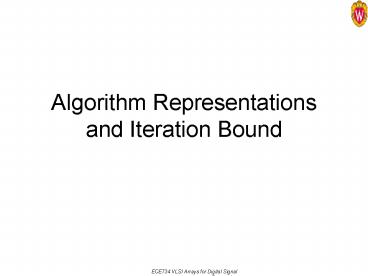Algorithm Representations and Iteration Bound - PowerPoint PPT Presentation
1 / 10
Title:
Algorithm Representations and Iteration Bound
Description:
... a new Graph Gd from the given DFG G. Each node of Gd is a delay ... mean of each cycle in Gd. ... Maximum cycle mean of Gd is the maximum cycle (loop) bound of all ... – PowerPoint PPT presentation
Number of Views:316
Avg rating:3.0/5.0
Title: Algorithm Representations and Iteration Bound
1
Algorithm Representations and Iteration Bound
2
Dependence Graph (DG)
- The basic representation of an algorithm.
- Shows only dependency among operations.
- No notion of delay is represented.
- No loop, cycle allowed.
- Can be used to represent asynchronous operations.
- Most useful in exploiting inherent parallelism in
the algorithm
- No implementation or hardware constraint are
imposed on DG.
3
Data Flow Graph
- Node
- Computation
- Associated with a computing time.
- Direct edge
- data path and delay
- Delay iteration count
- Example
- y(n) ay(n-1) bu(n)
- The delay of 1 u.t. indicates that to compute
y(n1) in the next iteration depends on result
y(n) of the present iteration. - Delay labeled with D or positive integer on edges
4
DFG
x(n)
D
D
- Intra-iteration dependency
- A direct edge without any delay
- Inter-iteration dependency
- Direct edge with 1 or more delays
- Node computing delay labeled with parenthesis.
- Critical path longest path between
- Example critical path delay 422 8 t.u.
M1
M2
(4)
(4)
M0
(4)
y(n)
A1
A0
(2)
(2)
- Recursive DFG contains loops. Must have at least
one delay element along any loop. Otherwise, the
algorithm is NON-computable!
5
Loop bound and Iteration bound
D
(2)
(5)
(4)
A
B
C
2D
(2)
(4)
A
B
- TA-B-A (24)/2 3 t.u.
- T? max(24)/2, (245)/1
- max3, 11 11
2D
6
Longest Path Matrix Algorithm
- Paths are from one delay element to another.
- Matrix L(m) dimension d by d, d of delay
elements - Element ?ij(m) longest computing time from
output of di to input of dj with exactly m-1
delays in between. If no such path exists,
?ij(m)-1. - Let K k k ?1, d, ?ik(1) gt -1 and ?kj(m) gt
-1, then
- Once L(m) is computed, the iteration bound can be
found as - This algorithm can be easily programmed once L(1)
is given.
7
LPM Example (Fig. 2.2)
- lpm.m
8
Minimum Cycle Mean Algorithm
- Create a new Graph Gd from the given DFG G. Each
node of Gd is a delay element in G. Edge from
node i to node j in Gd is the longest path from
delay i to delay j in G. So Gd can be constructed
from non-negative entries of L(1). - Compute cycle mean of each cycle in Gd. A cycle
mean is the average lengths of all eges in a
cycle - Maximum cycle mean of Gd is the maximum cycle
(loop) bound of all loops in G and hence is the
iteration bound.
- Algorithm
- Compute Gc whose edge is negative of that of G.
- Choose an arbitrary node s, such that fs(0)0,
fk(0) ?. - Iterations
- iteration bound
mcm.m
9
Example (Figure 2.4)
10
LPM and MCM for Fig. 2.4
- LPM Method
- MCM Method
- i-m matrix
- T? 8































